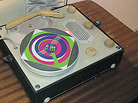Śląsk active (1) — has the qualities of energizing drink of same name

Śląsk Active 1 — artists
Katarzyna Bochenek, Sławek Brzoska, Marek Glinkowski, Małgorzata Jabłońska i Piotr Szewczyk, Ksawery Kaliski, Wojtek Kucharczyk, Marek Kuś, Leszek Lewandowski, Piotr Lutyński, Krzysztof Morcinek, Anna Nałęcka, Krystyna Pasterczyk, Wjosna, Jerzy Ziomber.
Originator of the cycle: Marek Kuś
Curators: Marek Kuś, Stach Ruksza

summary book of the actions cycle ‘Active Silesia’ The book ‘Active Silesia’ is a summary of the cycle of three exhibitions ‘Active Silesia’, which includes a wide range of...

Śląsk active (3) — is the spell taken off us? After the last edition of the cycle of exhibitions ‘Śląsk active’ the creation of two artists deserve special attention because of the coherence of expression....

Śląsk active (2) — in an active, beautiful and modern way The exhibition ‘Śląsk active 2’ at the BWA Contemporary Art Gallery in Katowice is the second presentation of works of the younger generation of artists, who...

It’s refreshing, regenerating and throwing off apathy.
The project ‘Śląsk active’ results from the need of revaluation, breaking the stereotypes of two dominant images of Silesian art: on the one hand the mythological/magical one, and on the other the academic one (the local cult of print and poster making, and traditional painting). These both images that are often mutually pervaded create an unchanging hierarchy, which is convenient to maintain local artistic infrastructure.
‘Śląsk active’ opposes to the total taking of art. It presents a nonlinear and fragmentary image, which is not strictly connected with institutions, and thus not ideologized.
‘Śląsk active’ is conceived to be the yearly meeting of artists.
The criterion (not generational) is to be ‘active’, open to investigations, and breaking former ways…
‘Śląsk active’ is an oxymoron. Both parts don’t match each other blatantly.
Anachronous conventions of artistic education and traditional orientation, which is often directed against current art and dominates the image of Silesian art, brought the stereotype of conservative Silesia.
To traditional disposition that is glorified by the statement of ‘adopting the extremely honest artistic attitudes’, ‘Śląsk active’ opposes the ideas of movement and changes. It prefers works in progress to the cult of work and handicraft; therefore conceptions and unfinished works can be also present during the meetings. The meetings of ‘Śląsk active’ are like a temporary reconstruction of a gallery in a laboratory…
‘Śląsk active’ doesn’t like claustrophobia and agoraphobia.
In the two functioning images of art in Silesia there is a pathological lack of placing the Silesian art within the general framework of Polish art. It looks as if it were a ‘self-sufficient environment’ with its positions, inspirations (sic!) or hierarchies, and abundant in overestimated the so-called ‘local celebrities’, what was shown by Grzegorz Dziamski in his survey presented in Art&Business magazine (‘Almost each bigger city has its own artistic greatnesses, I mean the artists that are well seen by local authorities and officials, pampered in various manners and surrounded by something in the shape of a cult.’ [in:] Art&Business No. 1-2/2004, p 22). ‘Śląsk active’ likes the space. Here Śląsk, or Silesia, is only a place treated as a starting point. Many artists which participate in these exhibitions function and have a great deal of clout outside the region. Thus ‘Śląsk active’ is highlighting its artistic potential, denying the trivial epithet of ‘cultural desert’, which has been often attributed to Silesia.
Stach Ruksza




